Personnel
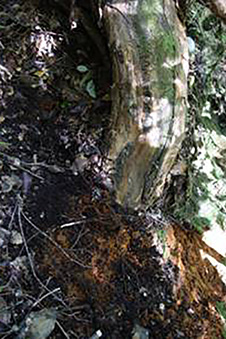
Trunk of a tree fuchsia growing in a substrate with 10-20% arsenic, Globe mine site, Reefton.
- Cathy Rufaut (ecologist)
- Laura Haffert (environmental scientist)
- Dave Craw (geologist)
Mines and mineral processing sites have disturbed land where pre-existing vegetation is cleared and soil is removed or buried. Commonly, the disturbed land surface becomes enriched in potentially toxic elements such as arsenic. These potentially toxic elements can have a negative impact on the immediate environment if they remain exposed for human contact, or physical and chemical erosion of the disturbed land affects nearby streams. Revegetation of metalliferous disturbed land at mine sites can result in biological stabilization and separation of the high element concentrations from the surface environment (phytostabilisation). Identification of plant species suitable for phytostabilisation is best done by observation of plants that naturally colonise the disturbed land of historic mine sites.
The aims of this study were two-fold:
- to identify plant species capable of naturally colonizing these high-arsenic substrates
- to measure levels of arsenic uptake in different species to identify suitable agents for phytostabilisation of high arsenic sites
This study examined three areas of arsenic-rich substrate near gold mines in Westland. Arsenic occurs naturally as the mineral arsenopyrite (FeAsS) with gold in ore that was mined at Globe Hill, near Reefton, and at the Prohibition mine near Waiuta, 40 km south of Reefton.
Global mine site
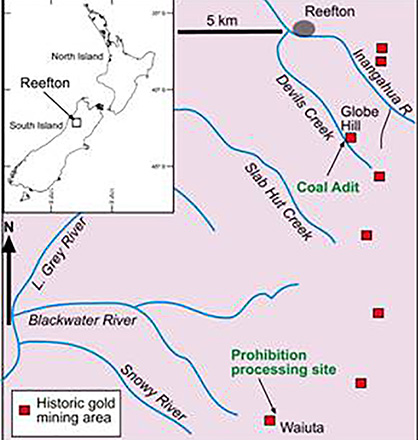
Coloured map indicating the whereabouts of the Reefton global mine site.
When the Globe mine was closed, ground water in the mine tunnels discharged through the lowest tunnel to a river. The discharging water had a high content of dissolved iron and arsenic, and some of this precipitated on oxidation at the entrance to the discharge tunnel. The precipitates are dominated by iron oxyhydroxide that have built up a half-cone shaped fan between the adit entrance and the river.
The regenerated forest surrounding the HFO fan is dominated by Nothofagus menziesii and N. fusca trees up to 10 m tall, with an understorey of shrubs, mainly Griselinia littoralis (Table 1). The forest floor has scattered moss and fern species. The water has up to 23 mg/L dissolved arsenic at a pH of 7 to 7.5. The fan of precipitated material has between 10 and 20% arsenic, which is extremely high. This is about 1000 times higher than typical As-contaminated soils.
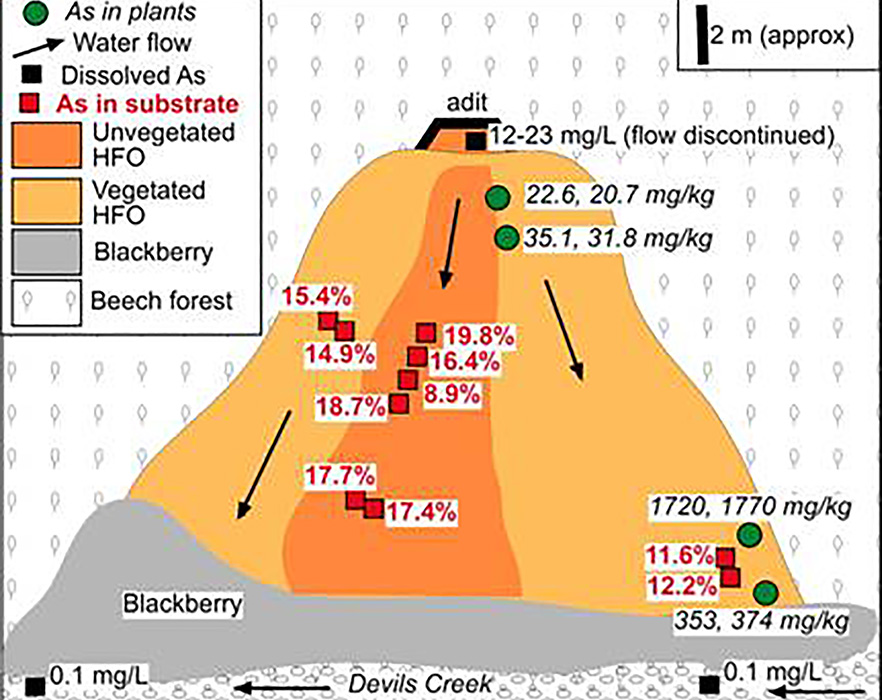
The regenerated forest surrounding the HFO fan is dominated by Nothofagus menziesii and N. fusca trees up to 10 m tall, with an understorey of shrubs, mainly Griselinia littoralis (Table 1).
Moss is the most abundant plant life on the HFO fan. In some places, ferns have colonized the mossy surfaces, with roots of larger ferns extended down into the HFO for up to 30 cm. Shrubs also appear to have colonized mossy surfaces. Their roots extend laterally for at least 1 m in the upper 20 cm of the HFO, and one Fuchsia excorticata (tree fuchsia) individual with a 20 cm diameter trunk was deeply rooted within the HFO. Samples of small branches and attached leaves from Fuchsia excorticata and Griselinia littoralis (broadleaf) shrubs growing in HFO had <36 mg/kg As. Leaves from large Blechnum discolor (crown fern) had up to 374 mg/kg As, and leaves from the moss species Heteroscyphus coalitis up to 1800 mg/kg As.
Clearly, the shrubs have a mechanism for excluding arsenic, and the ferns and mosses are highly arsenic tolerant.

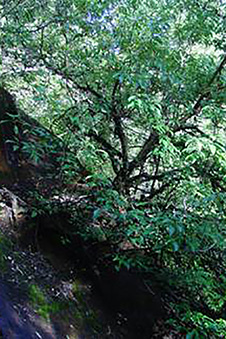
Historic mine tunnel discharging arsenic-bearing water on Globe Hill. The water is also precipitating brown iron oxyhydroxide, which helps to remove arsenic by adsorption
Prohibition mill site
The Prohibition mill treated ore from the nearby underground mine from 1938 to 1951. An ore concentrate rich in arsenopyrite was made in the mill, and heated in a roaster to release gold for recovery. Exhaust gases from the roaster precipitated arsenolite (As2O3) and this was saved as a byproduct. Remnants of this condensate, now coat the ground surface in the immediate vicinity of the processing plant ruins. Some of the arsenolite has transformed to scorodite (FeAsO4.2H2O). The pH of the As-rich substrates around the processing site ranges from 3 to 5. Arsenic concentrations are extreme, typically 10-30 wt%, and reaching up to 40% locally.
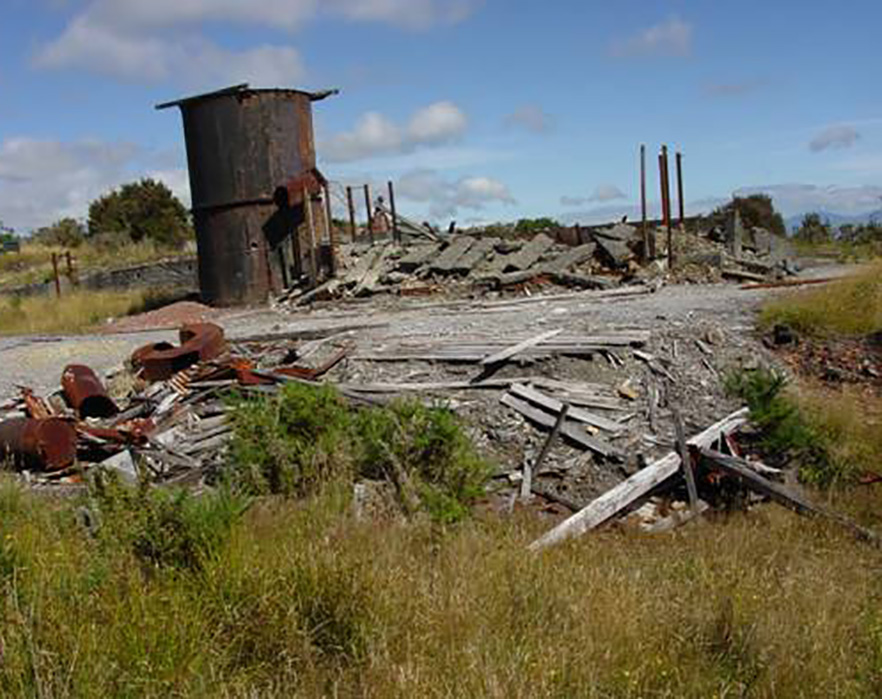
Prohibition mill site, with extremely As rich unvegetated waste material and margins of the site colonized by weedy species.
The area immediately around the mill is largely bare of vegetation, although some isolated clumps of Agrostis capillaris (browntop) and Hypochoeris radicata (catsear) have established. Small patches (<1m2) of moss (Campylopus pyroformis), locally in combination with Agrostis capillaris, Holcus lanatus (Yorkshire fog) and Hypochoeris radicata, have developed on small, brown silicate-rich deposits embedded within the predominatly bare grey arsenolite/scorodite-rich substrate. Moss (Campylopus pyroformis) defines the boundary between more extensive silicate-rich deposits and adjacent arsenic-rich substrate. A dense cover of intergrown grass and forb species has developed on the silicate-rich substrate. Foliage samples from this wild grass mix contained up to 11 mg/kg As (Table 2; Fig. 3). Foliage samples from a dense native stand of Leptospermum scoparium (manuka) growing nearby contain 1 mg/kg As.
Prohibition wetland
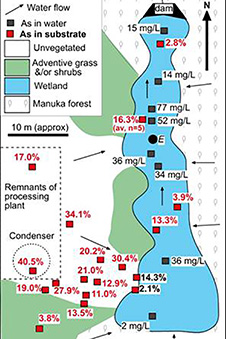
Map of the prohibition wetland.
The wetland immediately below the processing plant site was originally a tailings impoundment. This impoundment has developed into a vegetated wetland since the site was abandoned. Almost no open water remains except irregular patches near the centre of the wetland. Elsewhere, the wetland surface consists of variably saturated vegetation mats overlying a substrate of processing plant residue and sediment washed off the surrounding slopes. Water pH in the upper 10 cm of the wetland varies between 4.0 and 5.2. Arsenic concentrations of waters in the wetland range from 14 to 77 mg/L, with the highest values in the wettest part of the wetland
Vegetation in the driest parts of the wetland is dominated by adventive grasses and scattered native Leptospermum scoparium shrubs. Progressively wetter portions of the wetland showed increasing abundance of Juncus spp. (rushes). Fully saturated patches, including those with open water pools, contained the adventive Juncus articulatus in combination with moss. Large, dense mats of the adventive moss Pohlia wahlenbergii formed in and around ponds of open water.
The Leptospermum scoparium shrubs growing in the wetland have ca 3 mg/kg As. Arsenic contents in Juncus effusus are <7mg/kg. Arsenic in the wild grass mix also increased downstream through the wetland from ca 8 mg/kg to up to 803 mg/kg. Juncus articulatus samples contains arsenic up to 111 mg/kg. Analyses of the moss Pohlia wahlenbergii from the wettest part of the wetland were consistently high in As, up to 3 wt%.
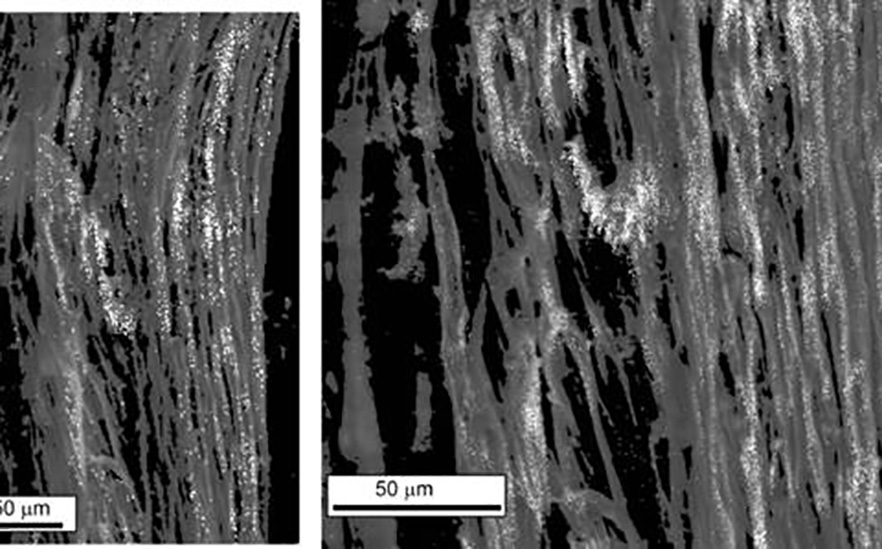
Electron microprobe detection of extreme arsenic levels (up to 3 wt%) in the moss Pohlia wahlenbergii. White dots indicate the location of relatively high As in the grey moss structure.
Conclusions
Natural plant colonization of these extreme arsenic rich areas shows that arsenic content of the substrate is not necessarily a hindrance to plant growth and phytostabilisation. Plant establishment in the high-As substrates may be locally limited by low nutrient status, rather than arsenic toxicity. The shrubs, grasses, and reeds identified in this study are arsenic tolerant and largely exclude arsenic from their shoots so that revegetation with these species, can help to isolate the high-arsenic substrates from the surface environment. These species could be used as phytostabilisation agents on high-arsenic sites that are remote from human habitation. In contrast, the mosses, despite their high arsenic tolerance, are a less desirable component of revegetation of high-arsenic substrates because they actively transfer arsenic from the substrate to the biosphere.
More information
Hewlett, L, Craw D & Black, A. 2005. Comparison of arsenic and trace metal contents of discharges from adjacent coal and gold mines, Reefton, New Zealand. Marine and Freshwater Research 56: 983-995.
Craw, D., Rufaut, C.G., Haffert, L., Paterson, L.A. 2007. Plant colonization and arsenic uptake on high arsenic mine wastes, New Zealand. Water, Air and Soil Pollution 179: 351-364.
